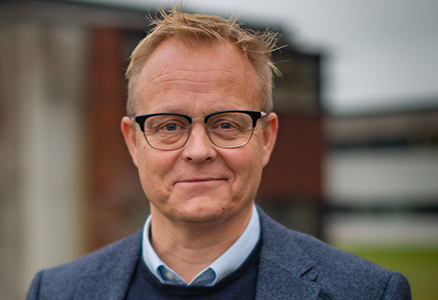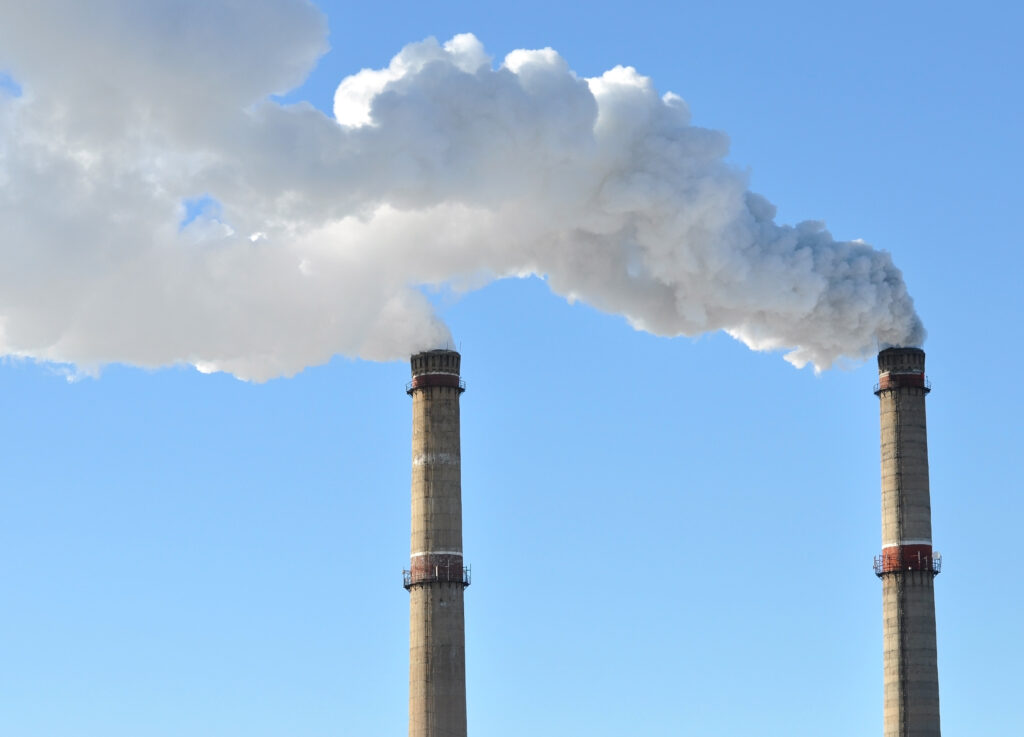We need an upside-down hockey stick

Interview
Professor Sebastian Mernild from the University of Southern Denmark (SDU) has contributed to work in the UN Intergovernmental Panel on Climate Change (IPCC). We must both reduce carbon emissions and develop new technologies for carbon capture and storage, because rapid reduction in the atmospheric content of greenhouse gases is crucial, he stresses.
Sebastian Mernild’s message is very clear. There’s no either-or with respect to reducing carbon emissions or capturing and storing carbon with artificial or nature-based solutions such as afforestation and biochar.
”We need it all, and at a pace we’ve not yet seen. Because reducing concentrations of greenhouse gases in the atmosphere is urgent and critical,” he stresses.
As a professor in glaciology and climate change, Sebastian Mernild is one of Denmark’s most recognised climate researchers. He is the head of the SDU’s Climate Cluster and author in the UN Intergovernmental Panel on Climate Change (IPCC), where he was the main author of the Sixth Assessment Report.
In the report, the SDU professor and his global researcher colleagues reviewed different scenarios to achieve the target to keep global warming below 1.5ºC. In none of the scenarios is carbon capture and storage, CCS, enough to ensure that we meet the climate targets. Large reductions, particularly in the consumption of fossil fuels, are required. Furthermore, we also need to develop and exploit the potentials in CCS, according to the researchers’ recommendation.
The IPCC applies a very large interval when estimating how much carbon can be captured and stored. In 2050, we will be able to store up to two to three gigatonnes of CO2e, according to a prudent estimate in the report. This corresponds to around 6% of the total reductions required.
The report points to technical, economic, environmental and socio-cultural barriers. There is still only a relatively modest number of CCS projects. But in 2021 alone, the number of projects tripled. Therefore, the effect may prove to be higher.
Sebastian Mernild explains that emissions of CO2, methane and other greenhouse gases have increased year by year, and so have temperatures. The global average temperature set a new record in 2023. Therefore, we must neither wait, nor write off specific technologies. Actual reductions in emissions from agriculture, construction, transport and the transition of the global energy sector to renewable energy sources are crucial instruments, but they cannot stand alone. We have to bring everything into play to reverse the growth in the atmospheric content of greenhouse gasses, as this is the only way we can curb temperature rises.
”We need a hockey stick – but it has to be turned around. It’s crucial that we reduce the amount of greenhouse gases in the atmosphere. And we have to do something as soon as possible. We’re approaching some of the critical tipping-points, and preferably we must never reach them. Therefore, we need to bring into use all the means we have available. New better and cheaper technologies may very well crop up along the way, but it can be very expensive to wait,” says Sebastian Mernild.
Failure to act now will have economic, environmental and climate costs. And there will be the human costs of extreme weather, with flooding and permanent changes making agricultural land hard to cultivate, with consequential famine and refugees.

Temperature rises can be self-reinforcing
Since 2005, the IPCC has pointed to the need for CCS, which usually entails capturing CO2 in the flue gas from energy production or industrial plants and compressing and storing it several kilometres under the ground in the stable layers. Besides this, there is also work to capture CO2 directly from the air.
It has been estimated that, with the known stores, it is possible to store CO2 in the subsurface corresponding to the current emissions up to the end of this century.
However, the debate on CCS often becomes polarized. In one corner, a number of the most climate-impacting industries and countries have been proponents of CCS.
And because CCS has appeared as – and perhaps also been meant as – an alternative to actual reductions in emissions of greenhouse gases, CCS has been seen as a diverting tactic. In the other corner are the advocates for first implementing full reductions of emissions in all places before moving on to storage. However, the one does not exclude the other. Carbon storage can supplement reductions. The debate has also run in Denmark, where CCS plays a crucial role in the government’s plan to achieve the climate targets.
Just as getting into good physical shape demands strength training and aerobic training, there is no reason to write off initiatives to reduce the quantity of carbon in the atmosphere.
Some years ago, Sebastian Mernild and his colleagues identified one of the critical tipping points that we are approaching. A global temperature rise exceeding 1.6ºC may have a significant impact on the ice sheet, he explains.
The surface of the ice sheet grows when it snows more than it melts. At the same time, the bottom melts, and icebergs calve out into the sea.
Temperature rises will shift this balance if surface melts faster than it grows when it snows, and this can cause increasing losses of ice and probably a self-reinforcing effect. Warmer temperatures will cause the ice sheet to shrink, so the top of the ice sheet lowers to where the temperature is higher, causing more ice to melt.
”This will cause ice losses to grow and grow. The ice sheet won’t be able to restore itself. Our studies indicate that this will happen if the global temperature rise gets to around 1.6ºC. Several of the Earth’s other major systems can approach critical tipping-points in the near future,” he says.
Huge potentials in biochar
One of the technologies with great potential to store carbon in the short term is pyrolytic treatment of agricultural residues to biochar. Through the process, carbon is bound in biochar, which can then be spread on farm fields, and the carbon will remain bound in the biochar for several hundred years.
It is possible to produce biochar from of all types of biomass. Everything from straw and wood chips to residual fibres from biomass can be converted to biochar through the pyrolysis process, in which the biomass is heated to at least 500-600ºC without oxygen. While biochar binds both carbon and nitrogen, phosphorus and potassium are released, so biochar could also contribute to soil improvement.
An action plan from the CIP Foundation in January 2024 shows that pyrolysis and biochar will be socio-economically advantageous compared with other types of CCS.
Anne Arhnung is a member of the board of directors of the CIP Foundation, and she explains that biochar could play the same role in the green transition of the agricultural sector as wind technology has done in the energy sector.
”The technology is mature and cheap, but framework conditions need to be in place as soon as possible, so that a market can be established in the area,” says Anne Arhnung.
The North Sea can be used for carbon storage
The relatively slow development of CCS is partly because of the drastically falling prices of solar and wind energy. The price of PV solar modules has plunged since the turn of the millennium, and with a few small bumps in the curve, the same applies for onshore and offshore wind power. Economists have calculated that it is cheaper to save carbon emissions by replacing fossil power plants with wind and solar energy than to deploy CCS.
”With respect to security, there’s no reason to fear release of the stored carbon. The carbon will be stored in the same soil layers as have stored oil for thousands of years. They’re called impermeable clay layers, and greenhouse gases cannot penetrate them,” says Sebastian Mernild, who stresses that this is not his research field, but knowledge from his colleagues.
Denmark is already well on the way. March 2023 saw the start of Project Greensand, which will exploit the subsurface under the North Sea for carbon storage. This turns history in full circle. From oil and gas production beginning in the 1970s, to storing unwanted by-products from fossil fuels 50 years later.
Project Greensand is very exciting. But it is far from enough to meet the point at the top of Sebastian Mernild’s wish list. In short: Scale.
”We have to scale-up for any sort of real effect. Pilot projects are all very well; but we need to get projects out of the research labs to have any impact. We have global annual net emissions of 19 gigatonnes of CO2e, so it’s urgent,” he says.

The climate follows the laws of physics
There is a good probability that this relatively new technology could bring a technological leap similar to what we saw with solar and wind power, but it is important that the knowledge obtained through research and innovation is brought into play by companies and countries. Scaling CCS projects will contribute to further innovation. More projects will increase volume to gather more experience and improve efficiency.
”The emissions curve has only gone up and up. Turning the curve is vital. In reality, not only emissions are crucial. The concentration of greenhouse gases in the atmosphere determines the temperature changes. It’s well known that the amount of greenhouse gases in the atmosphere, emissions and rising temperatures are closely linked. Time is the vital factor here. Therefore, I recommend an upside-down hockey stick,” says Sebastian Mernild.
As a researcher, he keeps out of the political debate. And sometimes, political intrigue can shift focus from what’s important, he points out.
The most recent temperature measurements indicate that we are very close to the 1.5-degree target in the Paris Agreement. However, it can be difficult to decide, because this is where politics quickly comes in. He needs an exact definition of how to calculate temperature rises.
”The climate doesn’t care about politics and definitions, so it quickly becomes just talk. Sure, there’s a lot of uncertainty. Both about the direct consequences for the climate, and about the consequences of extreme weather events, massive flows of refugees and other human disasters, but no matter whether we’ve exceeded 1.5 degrees or we’re close to it, the climate doesn’t care about definitions: For the climate, only physics matters,” he says.
Politicians can’t change the laws of physics. Therefore Sebastian Mernild once again stresses the importance of bringing all tools into play.
”We’ve pushed our climate system into an imbalance which may have insurmountable consequences. Therefore, we have to change gear. We have to act much faster, and we have to act across sectors. For example, we need more sustainable mobility and greener agriculture, construction and energy. We must remember to act internationally: the climate is indifferent to where the emissions come from. We also need technological solutions such as CCS, and we must change our behaviour: everything from our eating habits to our consumption is at stake,” he says.
